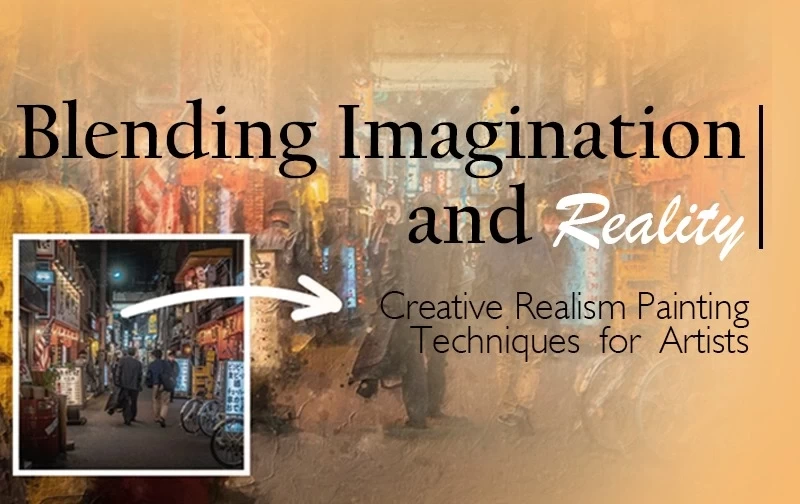LET'S REVIVE YOUR WALL
- Home
- Blog Detail

Blending Imagination and Reality: Creative Realism Painting Techniques for Artists
- August 21, 2024,
Overview
The world of art constantly evolves, offering endless opportunities for artists to explore new horizons while paying homage to classical techniques. One of the most fascinating realms within this evolution is creative realism painting—a style that masterfully blends imagination with reality, pushing the boundaries of what is seen and what is felt. For artists striving to capture not just the image of the world around them but the essence of life itself, creative realism offers a captivating challenge.
Understanding the Realism Painting Style
Before diving into the nuances of creative realism, it's essential to first understand the foundations of realism painting. Originating in the mid-19th century, realism aimed to represent subjects with an objective accuracy, free from idealization. Artists like Gustave Courbet and Édouard Manet pioneered the movement by depicting ordinary scenes and people with a focus on truthfulness rather than romanticism. The best realism paintings offer viewers an honest portrayal of the world, yet leave enough room for personal interpretation and connection.
Realism's painting style is distinct in its attention to detail, with artists employing meticulous techniques to replicate texture, light, and perspective as seen in the physical world. Realistic painting on canvas often requires hours of observation, precision, and patience to achieve life-like results. This dedication is what separates realism from other artistic styles and provides a solid platform for further creativity.
The Emergence of Creative Realism
Creative realism takes the foundational principles of realism and blends them with imaginative elements to create a unique and engaging style. In this approach, artists maintain the detailed representation of reality but add imaginative twists, surreal aspects, or emotive elements that elevate the painting beyond mere representation. The result is artwork that feels both familiar and otherworldly, inviting viewers to explore deeper layers of meaning.
The fusion of reality and imagination is evident in modern creative realism paintings, where artists depict realistic figures or scenes but often with dreamlike qualities—floating objects, distorted proportions, or exaggerated lighting. This approach breathes life into traditional realism, allowing artists to inject their personal vision and artistic flair.
Techniques for Mastering Creative Realism
For artists looking to blend imagination and reality, creative realism offers a unique challenge and endless possibilities. Here are several techniques to consider when mastering this style:
Observation and Study: Just like traditional realism, creative realism relies on a keen eye for detail. Spend time observing your subject in different lighting conditions, angles, and moods. Studying anatomy, texture, and nature will provide a strong foundation for capturing the essence of reality in your work.
Layering and Glazing: Creative realism often involves building layers of paint to achieve depth and texture. The glazing technique, where thin, transparent layers of paint are applied over one another, can help create luminous effects and enhance the realism of your piece. Layering also allows artists to integrate imaginative elements seamlessly into realistic scenes.
Imaginative Composition: One of the defining characteristics of creative realism is the incorporation of imaginative elements into realistic settings. To achieve this, experiment with unconventional compositions. Consider juxtaposing ordinary subjects with surreal backgrounds, adding symbolic imagery, or playing with scale and perspective. This blend of imagination and reality creates a dynamic interplay that draws the viewer in.
Mastering Light and Shadow: The manipulation of light and shadow is critical in realism painting. Creative realism takes this a step further by using light not only to define form but also to create mood and emotion. Play with exaggerated lighting, unexpected shadows, or ethereal glow to give your work an imaginative quality while staying true to realistic principles.
Textural Contrast: While realism often focuses on smooth, seamless transitions between textures, creative realism embraces contrast. Artists can juxtapose highly detailed areas with loose, abstract brushstrokes, or combine realistic textures with surreal, imaginary ones. This technique adds an element of surprise and depth to the work.
Materials and Tools for Realism Artists
Choosing the right materials is essential when working in creative realism. Canvas realistic painting offers a durable and flexible surface for the detailed work required in realism. Depending on the style and finish you prefer, you can opt for linen canvas for smoother detail or cotton canvas for a more textured look.
When it comes to brushes, realism painting demands a variety of sizes and shapes. Fine detail brushes are essential for intricate work, while broader brushes help with layering and blending larger areas. Additionally, high-quality paints, particularly oils or acrylics, are critical for achieving the depth and vibrancy often associated with creative realism.
Supplies for realism painting are easily accessible through online shopping, with platforms offering a wide range of products. Armaan National Supplies is one such resource, offering everything from top-quality paints to specialized brushes designed to meet the needs of realism artists.
Finding Your Style and Voice
Creative realism is a genre that invites personal expression. While technical skill is essential, the true magic of this style lies in the artist’s ability to convey emotion and story through their imaginative interpretation of reality. Explore different subject matter, experiment with various techniques, and develop your unique voice within the style.
Whether you're painting portraits, landscapes, or still life, allow your imagination to guide your work while maintaining a strong foundation in realism techniques. The best realism paintings are those that not only depict life with accuracy but also resonate with viewers on a deeper, more emotional level.
Summary
Blending imagination and reality through creative realism painting techniques allows artists to push the boundaries of traditional realism while still honoring its core principles. By mastering observation, layering, imaginative composition, and the manipulation of light and texture, artists can create works that captivate and inspire.
With platforms like Armaan National Supplies offering high-quality materials for realism painting online shopping, there has never been a better time to dive into the world of creative realism. Embrace the challenge, and let your art become a bridge between the seen and the unseen, the real and the imagined.

